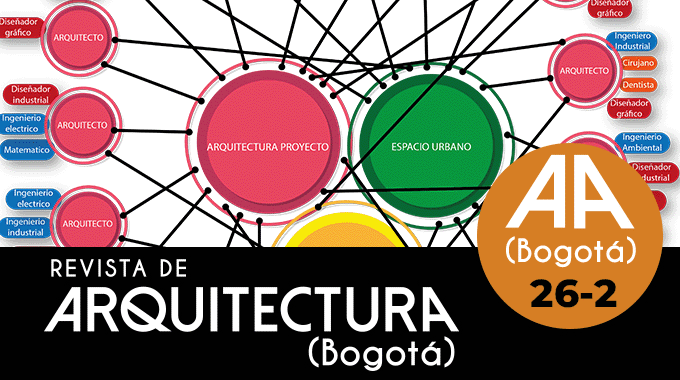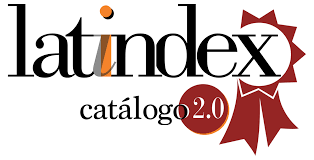

This work is licensed under a Creative Commons Attribution-NonCommercial 4.0 International License.
Revista de Arquitectura is an open access journal. More information...
Authors retain copyright and grant to the Revista de Arquitectura the right of first publication, which will be simultaneously subject to the Creative Commons (CC) BY-NC license.
Authors will sign a non-exclusive distribution license for the published version of the article by completing (RevArq FP03 Permission to Reproduce).
Self-archiving will comply with SHERPA/RoMEO guidelines and the Green classification.
To see in detail these guidelines, please consult...
Abstract
This study analyses interdisciplinary connections in architectural research through an examination of the Revista de Arquitectura (Bogotá) between 2018 and 2023. Despite advances in architectural research, the need to adopt an interdisciplinary approach is evident to comprehensively address contemporary challenges in architecture and enhance its relevance in the discipline. The methodology employed is qualitative and longitudinal, including literature review, analysis of journal metadata, and surveys of authors and peer reviewers. The results
reveal a growing trend towards interdisciplinary research in architecture, demonstrating an interest in exploring new frontiers of knowledge and addressing complex problems from multiple perspectives. The study highlights future opportunities in interdisciplinary research in architecture, providing a solid basis for future interdisciplinary developments and collaborations. It underscores the importance of fostering collaboration between disciplines to tackle current challenges in architecture, promoting the generation of new knowledge and enriching dialogue
between areas of study.

References
Augsburg, T. (2016). Becoming interdisciplinary: An introduction to interdisciplinary studies (3rd ed). Kendall Hunt. https://www.researchgate.net/publication/289378321_Becoming_Interdisciplinary_An_Introduction_to_Interdisciplinary_Studies_3rd_Ed
Barreto, M. Á. (2006). La interdisciplina en el abordaje académico del hábitat social “informal”: Fundamentos, líneas de acción y obstáculos a partir de la carrera de arquitectura. Revista INVI, 21(56). https://doi.org/10.5354/0718-8358.2006.62150
Follari, R. (2005). La interdisciplina revisitada. Andamios, 1(2), 7-17. http://www.scielo.org.mx/scielo.php?script=sci_arttext&pid=S1870-00632005000300001&lng=es&tlng=es
Infante-Malachias M. E., & Araya-Crisóstomo, S. (2023). Interdisciplinariedad como desafío para educar en la contemporaneidad DOSSIER - Valorización docente en el contexto de Brasil y de Chile frente a las marchas y contramarchas del neoliberalismo. Educ. rev. 39. https://doi.org/10.1590/1984-0411.88371
Jáuregui, J. M. (s.f.). Urbanismo y transdisciplinariedad. Intersecciones (Puntuaciones en relación con el abordaje de la articulación de lo formal y lo informal en América Latina). http://www.jauregui.arq.br/transdisciplinariedad.html
Madero Gómez, M. A., & Ballesteros Mejía, M. (2021). La investigación-creación como detonadora de nuevas indagaciones. Hojas de El Bosque, 8(14). https://doi.org/10.18270/heb.v8i14.3703
Matarrese, M., & Vilchis Esquivel, L. de C. (2020). Investigar en diseño. Multiplicidades epistemológicas y estéticas desde las que analizar la disciplina. Cuadernos del Centro de Estudios en Diseño y Comunicación [Ensayos] (82). https://doi.org/10.18682/cdc.vi82
Max-Neef, M. A. (2005). Foundations of transdisciplinarity. Ecological economics, 53(1), 5-16. https://doi.org/10.1016/j.ecolecon.2005.01.014
Moreno Toledano L. A. (2015). Complejidad, transdisciplinariedad y proyecto: Alcances y estrategias para el diseño en el siglo XXI [Tesis doctoral]. Universidad de las Américas Puebla.
Nicolescu, B. (2002). Manifesto of transdisciplinarity. SUNY Press [Trad. Karen-Claire Voss]. https://books.google.com.co/books?hl=es&lr=&id=jxJDlYTlAQ8C&oi=fnd&pg=PA1&ots=xZ5uv3gq5Z&sig=C8Y47rM-h6H3Ym6G_-3BpBkBpLU&redir_esc=y#v=onepage&q&f=false
OCDE. (2015). Frascati Manual 2015: Guidelines for collecting and reporting data on research and experimental development, the measurement of scientific, technological and innovation activities. OECD Publishing. https://doi.org/10.1787/9789264239012-en
Posada Álvarez, R. (2004). Formación superior basada en competencias, interdisciplinariedad y trabajo autónomo del estudiante. Revista Iberoamericana de Educación, 35(1) Extra 1. https://rieoei.org/historico/deloslectores/648Posada.PDF
Rodríguez, M. (s.f.). La interdisciplinariedad: Acción comunicativa científica y humana. Centro de Servicios Pedagógicos. https://ayura.udea.edu.co/servicios/1_5.htm
Sotolongo, P. L., & Delgado, C. J. (2006). La revolución contemporánea del saber y la complejidad social. En La complejidad y el diálogo transdisciplinario de saberes (cap. IV). http://bibliotecavirtual.clacso.org.ar/ar/libros/campus/soto/Capitulo %20IV.pdf
Stokols, D. (2006). Toward a science of transdisciplinary action research. Am J Community Psychol., 38, 63–77 https://doi.org/10.1007/s10464-006-9060-5
Tresserras, J. (2015). Diseño e interdisciplinariedad. Una visión. on the w@terfront. Public Art.Urban Design.Civic Participation.Urban Regeneration, 34(2), 5-18. https://revistes.ub.edu/index.php/waterfront/article/view/18829
Valle, M. (2005). Comunicación: disciplinariedad, interdisciplinaridad y transdiciplariedad. Revista Comunicologí@: indicios y conjeturas, Primera Época (3). http://revistacomunicologia.org/index.php?option=com_content&task=view&id=95&Itemid=89
Van del Linde Mejía, G. E. (2007) ). ¿Por qué es importante la interdisciplinariedad en la educación superior? Cuadernos de Pedagogía Universitaria, 4(8), 11-13. http://hdl.handle.net/20.500.12060/470
































